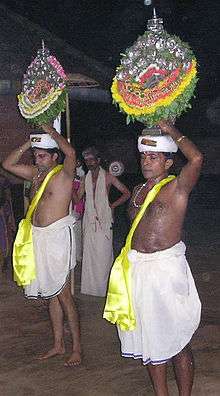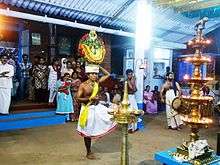Thidambu Nritham
Thidambu Nritham (dance with the replica of the deity) is a ritual dance performed in Temples of North Malabar. This is one among many rich art traditions of North Malabar. It is mainly performed by Namboothiris, and rarely other Brahmin communities like Shivalli, Karhade and Havyaka. North Malabar is well renowned for its deep rooted culture and tradition. This northern part of present Kerala State is home for several prominent religious destinations that make it a heaven for several unique religious and ritual art forms including Theyyam. Thidambu Nritham is one such ritual art form.

Thidambu Nritham, as the name conveys, is an elegant dance carrying the decorated image of the deity ( thidambu) on the head.[1]
Elements
This art form is staged both inside and outside the temple. Ten persons are needed for staging this dance. The dance is performed with the decorated deity of the Devi carried on the head. Foot work is most important and this is executed to the rhythms of the drums. Thidambu nritham is commonly performed by Namboothiris (Kerala Brahmins). There shall be seven musicians and two lamp-bearers.[2] All the performers are male. The musicians are from Marar or Pothuval community and the lamp-bearers are from Pushpakan (Unni), Nambeesan, Variar, Unnithiricommunities.
Costumes
The dancer wears a striking costume a skirt of pleated cloth, a silk vest, earrings, bangles, necklaces and a decorated turban called ushnipeetam. The performance unfolds in various stages like Urayal, invoking the deity,Thakiladi adantha, Chembada, Pamchan etc. The dancer is usually accompanied by a group of artistes, five of whom play the percussions and two hold aloft the lamps.[3]
History
This ritual art form is believed to be over 600–700 years old and follows the principles of dance laid down in Natyasasthra the ancient treatise on performing arts compiled by Sage Bharatha in the second century B.C.This ritual is commonly performed by Namboodiris at temples in Kannur and Kasaragod of Kerala.[4]
The origin of Thitambu Nritham cannot be easily traced. Tulu Brahmins who had migrated to the North Malabar during Kolathiri might have introduced this dance from Karnataka where a form of "Nritham" called "Darsana Bali" was in vogue. Replicas are made of bamboo with which a beautiful frame with intricate designs is created. The priestly dancer, clad in the traditional style after performing the usual rituals, comes out of the sanctorum, and standing under the flag, holds aloft the replica weighing about 10 kg on his head and starts the divine dance. Another legend goes like this : A Namboothiri used to sit in meditation under a nux vomica tree [Botanical name : Stricnos nuxvomica; Mal. - "Kaanjiram"]. He had sores all over his body. The fruit that occasionally fell on his body gave him excruciating pain. In agony he cried out a curse : "Let this tree bear no fruit any longer". Even today the tree bears no fruit, though it has leaves. It is interesting that during the festival, the dancing Namboothiri priests place the idols of various gods in a small "Mandapam" under the tree. People pay obeisance to the deities here.[5]
Performance
.jpg)
Thidambu Nritham begins with "Kotti Urayikkal", drumming in different rhythm, which would persuade the performer and the viewer to an equal extent. The performer will dance with the rhythm holding the "Thidambu" on his head and will create a holy atmosphere. This unique ritual art form has undergone changes over the period of time. Even though the basic concepts of Thidamabu Nritham have not changed, slight change happened in its Thaalam, which has added more novelty and variety to this art. There is no scope for emotional expressions in this art. An exception is famous "Kootippiriyal" (parting of lord Krishna and Balarama) at Trichambaram. The occasion is very touching with thousands watching with tearful joy, Krishna and Balarama playing about wildly until the former runs after the milkman carrying milk, and the latter returns to his dwelling some distance away. There is a legend woven round the Thitambu Nritham of Thrichambaram. There was an ardent devotee of lord Krishna - a Namboothiri. He visited the temple everyday, seeking Krishna's blessings. Time flew. He grew old, so old that he could not walk up to the temple half a kilometer away. Inwardly crushed at his physical incapacity, he prayed : "Krishna, my dear, I cannot come to you; forgive me". Legend has it that, that night, lord Krishna ran up to him with his brother Balarama and danced along what is called "Pookkottu Nada" just in front of the Namboothiri's house. The wonder and delight of the Namboothiri can well be imagined. The famous festival at Trichambaram which goes on from 22nd Kumbham to 6th Meenam (middle March) is in celebration of that event. During the festival, the "Melsaanthis" of Trichambaram and Mazhoor (Balarama's temple) hold aloft the replicas of the two deities and dance to the scintillating rhythm of percussion instruments. [6]
Famous Artists
Brahmasree Puthumana Govindan Namboothiri, resident of Puthumana Illam,Chemmattam Vayal, kanhangad is a famous and distinguished thitampu nritham artist (expert) at temples.[7]

Brahmasree Puthumana Govindan Namboothiri (48), is a legend in the field of Thitampu Nritham.He hails from Chemmattam Vayal, kanhangad in Kasaragod district. He has performed at almost all the temples in north Kerala.He is also famous at the National level throughout India. Video clippings of his performance is even included in the topics of interest of the dance researchers in the foreign universities. Thitampu Nritham exponent Sri Govindan Namboothiri, is now also well known for developing and rejuvenating this dance form. He was recently honoured by many organizations for having brought out all the possibilities of this temple dance form.He was given the titles ‘Janakeeya Narthakan’ and ‘Thitampu Nritha Chakravarthy’ for the outstanding and valuable contributions in this field.He has received many honours during the past years from well known temples.He is known to majority of celebrities in other fields as ‘Thitampu Nritha Prathibha’.His style of performing Thitampu Nritham is unique and makes attractive to the viewers even without the knowledge of this divine art. It is always found that there will be a large crowd to watch this performance from areas far away from temples. He keeps all the conventional styles as such with varieties which comes under the new trend. He is becoming popular nowadays as he always sticks only to this art and never tries to copy other dances and art forms.Every year he performs at new temples in North Kerala and Karnataka. He has delighted crowds in various parts of Karnataka including Mangalore and Bangalore apart from the fans in Trivandrum, Kochi, Thrissur and Calicut. It is a measure of his fame that people even from far way places crowd to the temples where he is a performer. Every year Govindan Namboothiri gets invitations from new temples. Such is his popularity.He comes to perform Thitampu Nritham under request which has fascinated thousands of viewers (art lovers) and devotees.He is known as ‘GURUJI’ to the performers of other classical dance forms. A majority of his fans believes that the honors received by him so far is not sufficient to greet him for his excellence and the dedication he shows in this field. There are many senior and great experts in Northern part of Kerala and Southern region of Karnataka performing another ritual, similar in appearance called 'darshanabali'.
References
- "Malayala Manorama online : Thidambu Nritham". Archived from the original on 14 July 2011.
- "Kerala dotcom : Thidambu Nritham of Temples". Archived from the original on 27 July 2011.
- "Puraana Keralam : Temple Arts viz Thidambu Nritham".
- Prabhakaran. "Fading away after 700 years". Retrieved 12 December 2018.
- "India Arts :Indian Temple Arts of Kerala". Archived from the original on 28 May 2012.
- "Our own Kerala :Kerala Thitambu Nritham in North malabar".
- "Munpathe Keralam: Artists of Thitambu Nritham".
External links
| Wikimedia Commons has media related to Thidambu Nritham. |